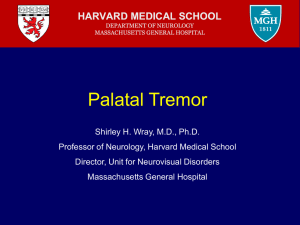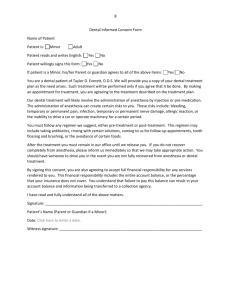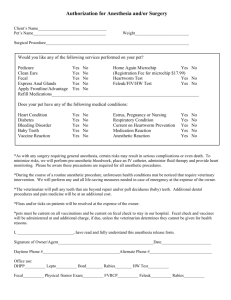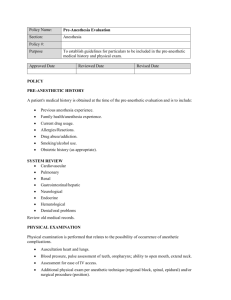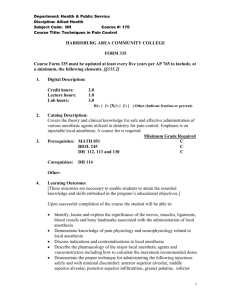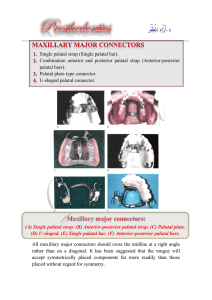x Bashar A. Tawfeeq – FICMS. MaxFacs
advertisement
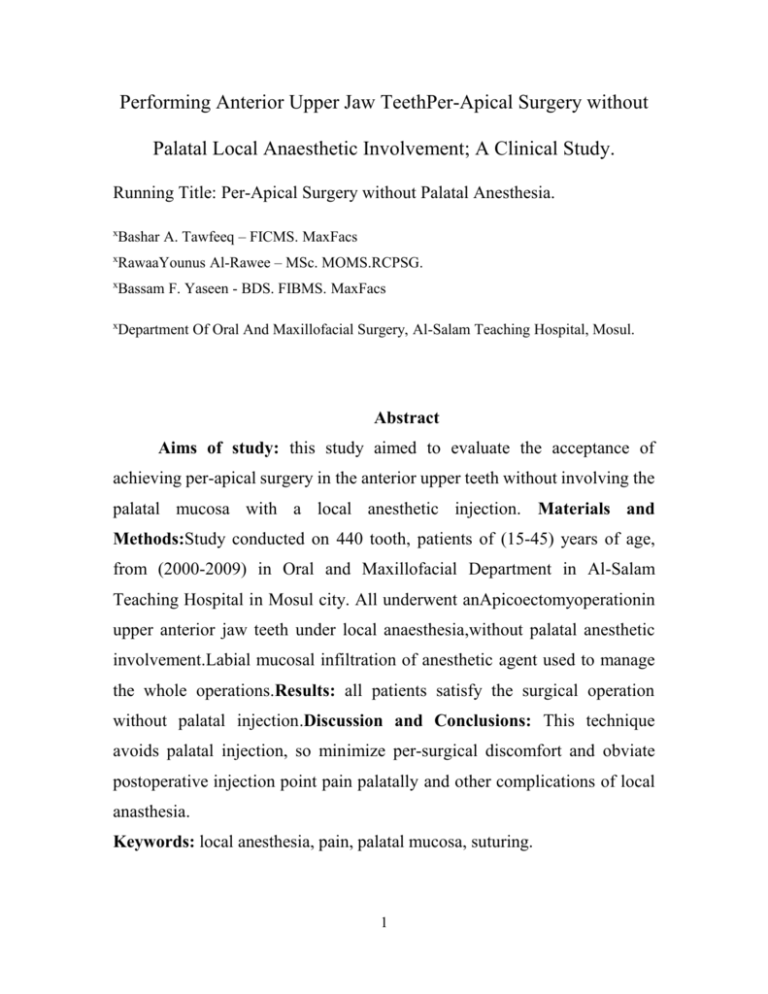
Performing Anterior Upper Jaw TeethPer-Apical Surgery without Palatal Local Anaesthetic Involvement; A Clinical Study. Running Title: Per-Apical Surgery without Palatal Anesthesia. Bashar A. Tawfeeq – FICMS. MaxFacs x RawaaYounus Al-Rawee – MSc. MOMS.RCPSG. x x Bassam F. Yaseen - BDS. FIBMS. MaxFacs x Department Of Oral And Maxillofacial Surgery, Al-Salam Teaching Hospital, Mosul. Abstract Aims of study: this study aimed to evaluate the acceptance of achieving per-apical surgery in the anterior upper teeth without involving the palatal mucosa with a local anesthetic injection. Materials and Methods:Study conducted on 440 tooth, patients of (15-45) years of age, from (2000-2009) in Oral and Maxillofacial Department in Al-Salam Teaching Hospital in Mosul city. All underwent anApicoectomyoperationin upper anterior jaw teeth under local anaesthesia,without palatal anesthetic involvement.Labial mucosal infiltration of anesthetic agent used to manage the whole operations.Results: all patients satisfy the surgical operation without palatal injection.Discussion and Conclusions: This technique avoids palatal injection, so minimize per-surgical discomfort and obviate postoperative injection point pain palatally and other complications of local anasthesia. Keywords: local anesthesia, pain, palatal mucosa, suturing. 1 INTRODUCTION The use of palatal anesthesia is a well-known procedure, and it has been described in detail in textbooks. Since it is a rather painful injection some techniques such as pressure anesthesia (5) (2) , electronic (3) , cryogenic (4) (1) , , or topical have been suggested to reduce the patient's discomfort. However, those methods are not universally effective(6), and some of them even require specific equipment (7) .andpalatal anesthesia remains a painful experience for most patients (6). Palatal injection for permanent maxillary tooth removal is poorly tolerated by the patients, and it is one of the most painful procedures in dentistry (8, 9). Piercing the mucosa is painful to a degree, but the main source of the pain is displacement of the mucoperiosteum(10). Recently, it has been claimed that maxillary permanent teeth could be extracted without palatal anesthesia(6,11). There are three opinions explaining the efficiency of the technique. First, it has been advocated that the anesthetic requirement for tooth extraction is not as high as that required for routine conservative dental treatment (12) . Second, it has been claimed that Articaine diffuses more readily through soft and hard tissues than other local anesthetics(11). Finally, it has been suggested that the porous nature of the maxilla facilitates the diffusion of any local anestheticsolusion(13). Aims of study: this study aimed to evaluate the patient acceptance and satisfactionof achievingperi-apical surgery in upper anterior teeth without involving the palatal mucosa with a local anesthetic injection. PATIENTS AND METHODS 2 ThisStudy conducted on440 anteriorteeth of upper jaw of210 patients, ranging from(15-45) years of age, from (2000-2009)in Oral andMaxillofacial Department in Al-Salam Teaching Hospital in Mosul city.All undergonapicoectomyoperationin upper jaw under local anaesthesia (1.8 ml lidocaine 2% with adrenaline 1\80000),without palatal mucosaanesthetic involvement.Labial mucosal infiltration of anesthetic drug is the only procedure used to manage the whole operations. The exclusion criteria include patients with apical lesions bulged palataly, those with spaced or lost teeth involved in the operative site including diastema and paediatric patients. The suturing technique was circumdental suturing (basket and corner type suture). The study pointed toward detection ofpatient’s feeling-pain throughout the surgical operation involving incision,peri-apical processing and suturing of the three sidedlabio-buccalmucoperiosteal flap. We explain to the patients who underwent the operative procedures, the possible unpleasant problems that may associated with the surgical techniquedue to exclusion of palatal mucosa anesthetic injection, all operations started approximately (6-8) minutes from last anesthetic injection to ensure effective vasoconstriction, twocartridges are used for an involved apical lesion for each tooth. The patients evaluated intra-operatively regarding presence or absence of pain.No sedative drugs were used pre-operatively. RESULTS For all patients underwent the upper jaw surgical procedures without palatal mucosa anesthetic involvement, nobody experience pain during the operation, including incision, retraction of the labio-buccalmucoperiosteal 3 flap, bone drilling for apical surgery curettage or apicoectomy and finally, flap’s suturing.The operator try to avoid any unnecessary contact with the palatal tissue during the operation especially at time of suturing, accordingly, circumdental suturing used to avoid any surgical trauma to the palatal side. In all operations, nobody necessitate an optional palatal injection.Throughout the operation, there is no interruption with the palatal mucosa. DISCUSSION The local anaesthetic solution should be delivered into the loose connective tissue of the alveolar mucosa near to the root apices(14). Circumdental suturing does not involve the palatal mucosa while securing the flap edges, ensure isolation of palatal mucosa throughout the suturing procedure out of needle tick. A study conducted by Kubilayet al improve that after an enough postanesthetic delay, it is possible to extract the maxillary teeth without palatal anesthesia and the technique is effective for all maxillary teeth. However, he mentioned that, palatal anesthesia is a must for the teeth requiring surgical procedures(15). We ensure that the palatal mucosa was not anesthetized by the indirect effect of labio-buccal infiltration by selecting a sample (20 patients) randomly and try to test the sensibility of pain by make a puncture with a dental needle in the palatal mucosa. Another study achieved by Richaet alwho recommend the use of periodontal ligament injection were a volume of solution of 0.2 to 0.4 ml per 4 rootwhich has several advantages, they consider the periodontal ligament injection more acceptable than direct painful palatal technique(16). We improve that peri-apical operation for upper teeth could be achieved and being effective without administration of palatal anesthesia, indeed, there is no anesthesia affecting the palatal mucosa transferred thought out the alveolar process from the buccal infiltrative anesthetic agent.Pediatric patients were not included in this study because they might not express the pain correctly. In conclusion, this technique avoids palatal injection, so minimize discomfort preoperatively and obviate postoperative injection point pain palatally. REFERENCES 1. McArdle BF. Painless palatal anesthesia. Journal of the American Dental Association. 1997;128(5):p. 647. [PubMed] 2. Kravitz J. The palatal press and roll anesthesia technique. Practical Procedures & Aesthetic Dentistry. 2006;18(4):242–245. [PubMed] 3. Meechan JG, Winter RA. A comparison of topical anaesthesia and electronic nerve stimulation for reducing the pain of intra-oral injections.British Dental Journal. 1996;181(9):333–335. [PubMed] 4. Duncan JD, Reeves GW, Fitchie JG. Technique to diminish discomfort from the palatal injection. The Journal of Prosthetic Dentistry.1992;67(6):901–902. [PubMed] 5. Meechan JG. Effective topical anesthetic agents and techniques. Dental Clinics of North America. 2002;46(4):759–766. [PubMed] 6. Fan S, Chen W-l, Yang Z-H, Huang Z-Q. Comparison of the efficiencies of permanent maxillary tooth removal performed with single buccal 5 infiltration versus routine buccal and palatal injection. Oral Surgery, Oral Medicine, Oral Pathology, Oral Radiology and Endodontology.2009;107(3):359–363. [PubMed] 7.Quarnstrom F. Electronic dental anesthesia. Anesthesia Progress. 1992;39(4-5):162–177. [PubMed] 8. Frazer M. Contributing factors and symptoms of stress in dental practice. British Dental Journal. 1992;173(3):p. 111. [PubMed] 9. Milgrom P, Coldwell SE, Getz T, Weinstein P, Ramsay DS. Four dimensions of fear of dental injections. Journal of the American Dental Association. 1997;128(6):756–762. 10. Harker T. What injection? British Dental Journal. 1997;182(2):p. 50. [PubMed] 11. Uckan S, Dayangac E, Araz K. Is permanent maxillary tooth removal without palatal injection possible? Oral Surgery, Oral Medicine, Oral Pathology, Oral Radiology and Endodontology. 2006;102:733– 735. [PubMed] 12. Roberts DH, Sowray JH, editors. Local Analgesia in Dentistry. 3rd edition. Bristol, UK: Wright; 1987. 13. Shields PW. Local anaesthesia and applied anatomy. Australian Dental Journal. 1986;31(5):319–325. [PubMed] 14. B. S. Chong & J. S. Rhodes, Endodontic surgery, British Dental Journal 216, 281 - 290 (2014) Published online: 21 March 2014 | doi:10.1038/sj.bdj.2014.220. 15. KubilayIsik, Abdullah Kalayci, and ErcanDurmus, Comparison of Depth of Anesthesia in Different Parts of Maxilla When Only Buccal Anesthesia Was Done for Maxillary Dent. 2011; 2011: 75874. 6 Teeth Extraction, Int J 16. RichaPrama, LeenaPadhye, Hitesh Pawar, Narpatsingh Rajput, Efficacy of Intraligamentary Injections as a Primary Anesthetic Technique for mandibular molars and a comparison with inferior alveolar nerve block, Indian Journal of Multidisciplinary Dentistry, Vol. 3, Issue 4, AugustOctober 2013. 7

